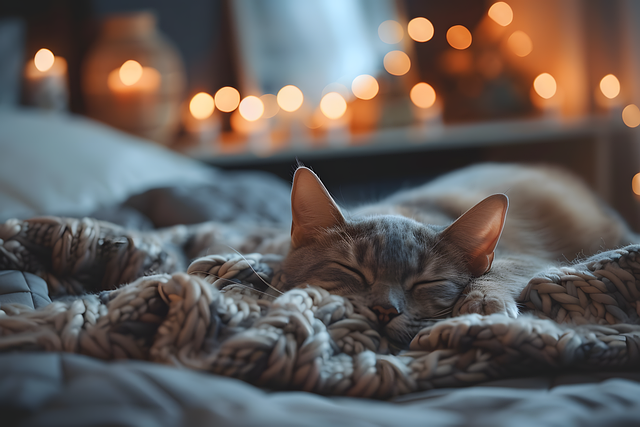As a cat owner, you understand the importance of keeping your feline friend happy, healthy, and entertained. Cats are curious and playful creatures by nature, and providing them with stimulating activities is essential for their overall well-being. While there are countless toys available in pet stores, homemade toys offer a unique opportunity to tailor the play experience to your cat’s preferences while also fostering creativity and strengthening the bond between you and your pet.
In this article, we will explore five delightful homemade toys that are sure to capture your cat’s attention and imagination. From simple cardboard scratchers to interactive feather wands, these DIY projects are not only cost-effective but also provide endless entertainment for your beloved feline companion.
Creating homemade toys for your cat is not only rewarding but also a great way to engage in hands-on activities that promote mental stimulation and physical exercise. By using materials that are readily available at home, you can unleash your creativity and customize toys that cater to your cat’s unique personality and interests.
Whether your cat enjoys chasing, pouncing, or scratching, there’s a homemade toy idea for every feline preference. These toys not only provide an outlet for your cat’s natural instincts but also help prevent boredom and destructive behavior.
Additionally, making homemade toys allows you to incorporate elements such as catnip or hidden treats to further enhance the play experience and keep your cat entertained for hours on end. By encouraging active play and exploration, you can create a happy and fulfilling environment for your cat to thrive in.
Join us as we embark on a journey of creativity and fun, discovering how to transform everyday materials into captivating toys that will bring joy and excitement to your cat’s life. Let’s unleash our inner DIY enthusiasts and embark on an adventure filled with laughter, play, and endless feline antics!
Toy 1: Cardboard Scratcher
Materials Needed:
- Sturdy cardboard box
- Scissors
- Pen
- Tape
Instructions:
- Begin by dismantling the cardboard box and laying it flat.
- Use the pen to outline a shape of your choice on the cardboard. It can be a simple shape like a circle or rectangle, or something more elaborate like a fish or heart.
- Carefully cut out the shape drawn on the cardboard using scissors.
- If desired, make additional cuts around the shape to create fringes or strips, which will provide an interesting texture for your cat to scratch.
- Fold the edges of the cardboard upwards to give stability to the scratcher.
- Use tape to secure the scratcher in a convenient location, such as the leg of a table or the side of a piece of furniture.
This simple cardboard scratcher not only offers an attractive surface for your cat to sharpen its claws but also provides a satisfying activity that helps prevent damage to your furniture.
Toy 2: Felt Balls
Materials Needed:
- Colored felt
- Scissors
- Thread and needle (optional)
- Catnip (optional)
Instructions:
- Cut the felt into thin strips approximately 2-3 centimeters wide.
- Take a strip of felt and roll it tightly to form a ball.
- Optionally, you can sew the ends of the felt strip together to ensure the ball remains intact. Otherwise, you can simply press the ends together.
- Repeat the process until you have created several felt balls.
- Optionally, you can add a little catnip inside each ball to further attract your cat’s attention.
Felt balls are perfect for chasing and catching games, providing physical exercise and mental stimulation for your cat.
Toy 3: Cardboard Tunnel
Materials Needed:
- Sturdy cardboard or thick paper
- Scissors
- Tape
Instructions:
- Unroll the cardboard and lay it flat on the ground.
- Fold the cardboard in half lengthwise to make it thicker and more sturdy.
- Begin rolling the cardboard along its length to form a tunnel.
- Use tape to secure the ends and ensure the tunnel stays in place.
- Optionally, you can cut windows or holes along the tunnel to add elements of surprise and fun for your cat.
A cardboard tunnel is a great way to encourage your cat’s natural exploration and hide-and-seek behavior. They love running, hiding, and sneaking through the tunnel, providing hours of entertainment.
Toy 4: Feather Wand
Materials Needed:
- A thin, flexible rod (such as a broom handle, a cat fishing rod, or something similar)
- Strong string
- Artificial feathers
- Tape (optional)
Instructions:
- Tie the string to the end of the rod, ensuring it is securely attached.
- Next, tie the feathers to the end of the string. Make sure to leave enough space for the feathers to move freely.
- Optionally, you can tape the feathers in place to ensure they stay in place during use.
- Gently shake the wand to make the feathers move, mimicking the movement of prey, and watch your cat have fun trying to catch them.
The feather wand is a classic toy that stimulates your cat’s hunting instinct, providing a fun and interactive play experience.
Toy 5: Activity Box
Materials Needed:
- A large cardboard box
- Scissors
- Pen
- Various objects to hide inside the box (such as paper balls, small toys, treats)
Instructions:
- Begin by cutting holes of different sizes in the cardboard box. These holes should be large enough for your cat to reach inside the box.
- Place the objects inside the box, hiding them in different compartments and behind the holes.
- Close the box and watch as your cat explores and discovers the hidden objects inside.
- Add more challenges by placing treats in sealed containers inside the box, encouraging your cat to find ways to open them.
An activity box is a fun and stimulating way to keep your cat busy and mentally engaged, offering an enriching play experience.
Conclusion
Congratulations on exploring these five amazing ideas for homemade toys for your cat! By creating these toys, you not only provide fun and entertainment for your feline but also strengthen the bond between you and promote an enriching environment for your cat.
Always remember to adapt the toys to your cat’s individual preferences and needs, ensuring they are safe and suitable for them. Additionally, always supervise the use of the toys to ensure your cat’s safety.
Try making these toys at home and observe the joy and enthusiasm they bring to your cat’s life. Be creative and have fun exploring new ways to pamper and care for your feline friend!
Keep an eye on our website for more tips, tricks, and ideas to keep your cat happy, healthy, and entertained. Together, we can create a happy and stimulating environment for our adorable four-legged friends.
Frequently Asked Questions (FAQs)
- How do I choose the best homemade toy for my cat?
- Consider your cat’s personality, preferences, and activity level. Experiment with different types of toys to see what captures their interest the most.
- Is it safe to use materials like felt and cardboard to make toys for cats?
- Yes, as long as the materials are non-toxic and free from small, ingestible parts. Always supervise your cat while playing with homemade toys to ensure their safety.
- My cat seems uninterested in homemade toys. What can I do?
- Try incorporating different textures, scents, or movements into the toys to make them more appealing to your cat. You can also try introducing the toys during playtime or associating them with treats to create positive associations.
- Why is it important to offer toys and activities for cats indoors?
- Indoor cats need mental and physical stimulation to prevent boredom and behavioral issues. Toys and activities provide an outlet for natural behaviors like hunting, chasing, and climbing, promoting a happy and healthy lifestyle.
- Can I let my cat play with homemade toys unsupervised?
- It’s generally best to supervise your cat while they play with any toy, homemade or store-bought, to ensure their safety. Remove any loose parts or potential hazards before leaving your cat alone with the toy.
- Are there materials I should avoid when making homemade toys for cats?
- Avoid using materials that could be harmful if ingested, such as small plastic pieces, toxic glues, or sharp objects. Stick to safe and non-toxic materials like cardboard, felt, and natural fibers.
- How can I encourage my cat to play with the homemade toys I made?
- Engage in interactive play sessions with your cat using the toys to demonstrate their purpose and appeal. Rotate the toys regularly to keep them interesting and introduce new ones gradually.
- What are the benefits of offering homemade toys for my cat compared to store-bought toys?
- Homemade toys are often more affordable, customizable, and environmentally friendly than store-bought toys. They also provide a unique bonding experience between you and your cat.
- Can I customize homemade toys according to my cat’s preferences?
- Absolutely! Homemade toys can be tailored to your cat’s individual preferences, such as incorporating their favorite textures, scents, or movements into the design.
- My cat loves the homemade toys. How much time should I dedicate to playing with him every day?
- Aim for at least 15-20 minutes of interactive playtime each day to keep your cat mentally and physically stimulated. Adjust the duration based on your cat’s energy levels and preferences.
- Can homemade toys replace store-bought toys?
- Homemade toys can complement store-bought toys and offer variety in your cat’s play routine. Both types of toys serve different purposes and can be equally enjoyable for your cat.
- My cat is getting bored with the toys I have at home. How can I keep him interested?
- Rotate the toys regularly to prevent boredom and introduce new ones periodically to keep your cat engaged. You can also try adding different scents or textures to the toys to make them more appealing.
- Can homemade toys help reduce my cat’s destructive behavior?
- Providing stimulating toys and activities can help redirect your cat’s energy and prevent destructive behaviors like scratching furniture or excessive meowing. Engage your cat in play sessions to channel their natural instincts in a positive way.
- My cat has allergies. How can I ensure that the materials of homemade toys are safe for him?
- Choose hypoallergenic materials for homemade toys, such as natural fibers like cotton or wool. Avoid using materials that could trigger your cat’s allergies, such as synthetic fabrics or strong scents.
- How do I clean homemade toys for my cat?
- Most homemade toys can be cleaned with mild soap and water. Ensure the toys are thoroughly dried before giving them back to your cat to prevent mold or mildew growth.
- What are some other creative ways to entertain my cat indoors?
- Create a DIY puzzle feeder, set up a cardboard maze, or build a cat tree using recycled materials. You can also try teaching your cat new tricks or playing interactive games like hide-and-seek to keep them mentally stimulated.

Juan López, a pet enthusiast since youth, shares his expertise and love for animals on his blog. With practical tips and profound insights, he guides readers toward a happier life alongside their furry companions.




